Creating Values With Meaning - What To Do and What You Need To Avoid
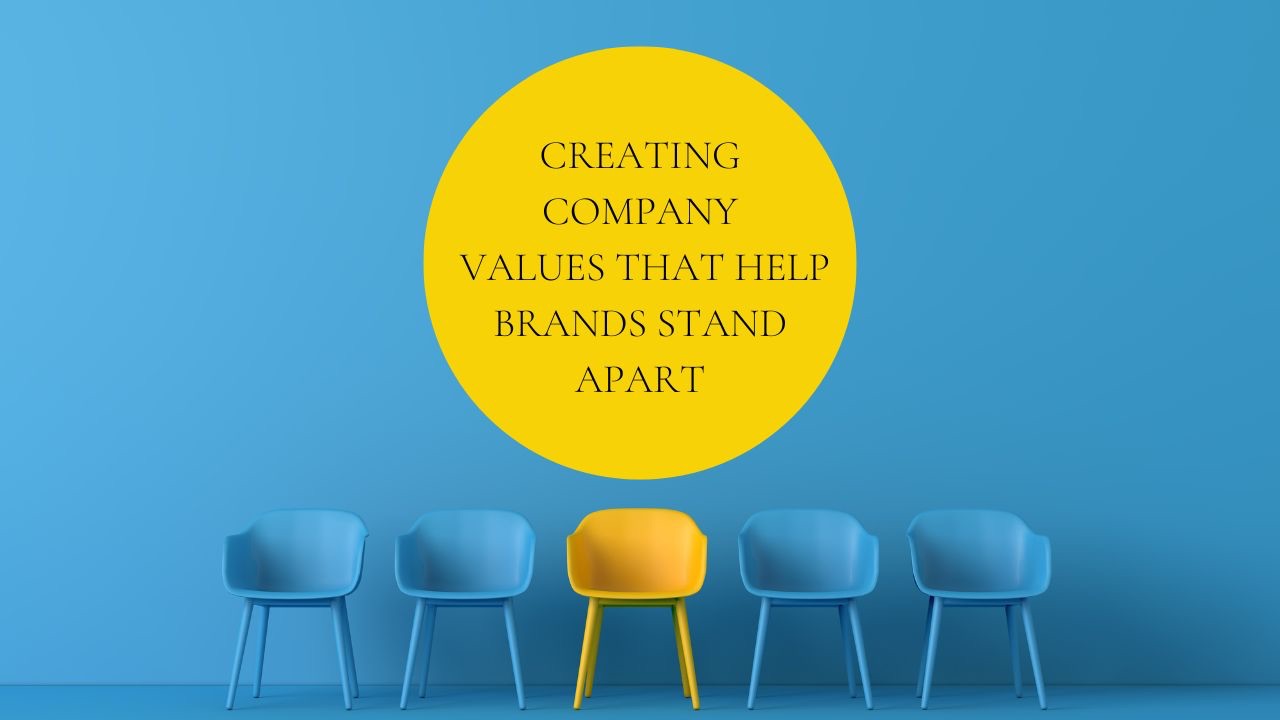
There’s some pretty bad advice out there when it comes to creating values.
It tends to go like this:
- Here are some examples of good values: Innovative, Honest, Open, Customer-Focused, Teamwork, Integrity, Accountability.
- Now just sit down with your leadership team and decide what yours should be.
- Then share them with everyone in your business.
- Oh - and make sure they are brought to life every day by everyone.
This doesn't work well.
It produces a top-down list of generic words that doesn't engage employees or the talent you are looking to attract.
It's a poor springboard for any cultural engagement program, because the words are so generic, no one knows what they are supposed to do to bring them to life.
At best you get business as usual. At worst it creates cynical, dispirited employees who leave to join a competitor with a more compelling culture, expressed in values they share and believe in.
The hard reality is that most employees don't even understand the cultural goals and values that leadership have in place. Gartner research shows that:
- 69% of employees don’t believe in the cultural goals set by their leaders
- 87% don’t understand them
- 90% don’t behave in ways that align with them.
And while leadership teams know they need to do better - 90% agreeing they could probably improve things, fewer than 20% are actually doing anything about it, according to a study by Duke University.
Now - just to be clear - values are by no means the be all and end all of creating a strong company culture. But they are a critical starting point.
So how can you create better company values?
How to create values with meaning
After working with over 60 companies to help them define values that actually make a difference, here's a better process to identify company values.
- Take a long hard look at the values you've got. Here are some examples of the most common values: Innovative, Honest, Open, Customer-Focused, Teamwork, Integrity, Accountability. If these read like yours then you need to work harder on them. Do the following:
- Engage with your employees to understand what they believe the values of the company are. Expose the good and the bad – what must never change and what needs to be different.
- At the same time, talk to the leadership team about their vision for the business and the culture that’s needed to support it. Get their take on what needs to remain and what needs to change in the behaviours and norms they observe to help them get there.
- Understand the heritage of the business – what values or beliefs it was founded upon, and what in the culture has helped to drive their success to date. If there’s a founder, listen carefully to their story – and understand any mantras, quotes, stories, myths that are part of the legacy of the brand.
- Analyse all of the above very carefully and come up with the broad themes the values could sit within.
- Look at your competitors' vales and the most commonly used values across all companies. AVOID these generic articulations.
- Work really hard to define a set of values that encapsulate the themes and analysis above. Meaningful to employees and different from your competition.
- Understand that this is just the tip of the iceberg. Now comes the hard work. Create a working group responsible for a roll out and engagement plan on how these values will be experienced by employees and customers.
- Understand that this is a forever, ongoing project, because this is integral to creating a culture that attracts and retains employees, customers, shareholders, and can make or break your business.
Let me break some of this down for you further.
Read on for:
- The values you need to avoid, and why.
- Why values are so important to get right for any company.
- How to write better values: with 20 examples from the world’s best companies of how to write better values.
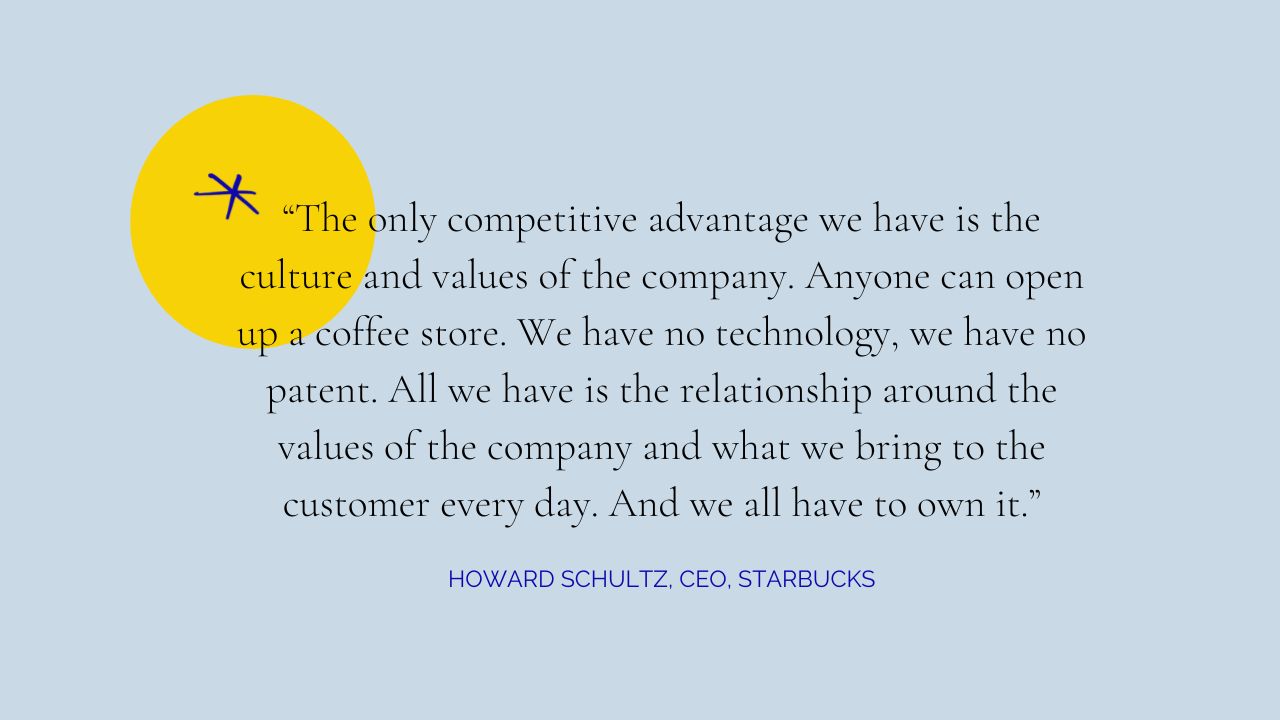
The values to avoid and why
Three major studies - a Booz Allen Hamilton/Aspen Institute across 365 companies and 30 countries; a Harvard Business Review Study of the Fortune 100; and a MIT Sloan Management Review of 562 large, organizations - showed great similarities across company values.
The first showed that 90% of organisations mention integrity, 76% trust and teamwork, 69% honesty and openness, 68% accountability, 60% innovative/entrepreneurial.
In HBR's research, 55% of all Fortune 100 companies claim integrity is a core value, 49% use customer satisfaction, and 40% tout teamwork.
And the most commonly occurring themes in the MIT Sloan study were integrity, respect and innovation.
So if your values look like this – they are doing very little to help anyone understand what’s special and different about your culture.
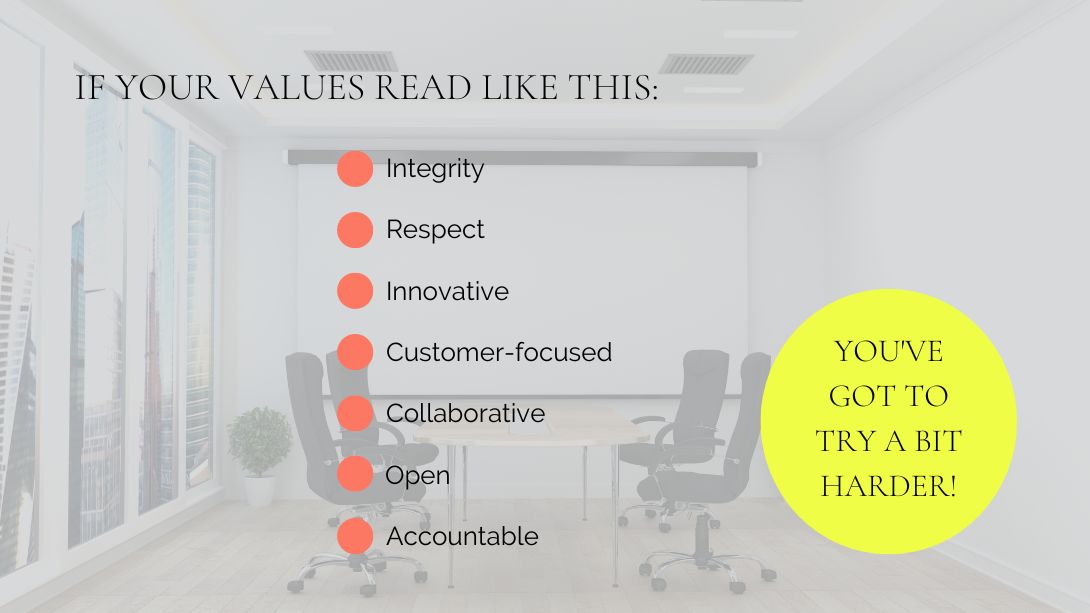
Why does this matter?
In the words of Patrick Lencioni in 'Make Your Values Mean Something' in Harvard Business Review:
Most values statements are bland, toothless, or just plain dishonest. And far from being harmless, as some executives assume, they’re often highly destructive. Empty values statements create cynical and dispirited employees, alienate customers, and undermine managerial credibility… Coming up with strong values—and sticking to them—requires real guts.
Strong values help to explain, shape and guide a culture.
And culture matters.
A lot.
- 91% of executives consider corporate culture to be “very important” or “important” at their firm, and 79% rank culture as at least a “top 5” factor among all of the things that make their firms valuable. (National Bureau of Economic Research)
- 35% of U.S. workers say they would pass on the perfect job if they felt the company culture wasn’t a good fit (Robert Half)
- Employees who don’t like their company’s culture are 24% more likely to quit their jobs (TINYpulse)
- According to research done by Hays, 47% of active job seekers are leaving their jobs because of company culture.
- More than 50% of CEOs and CFOs say corporate culture influences productivity, creativity, profitability, firm value and growth rates (Forbes)
- 15% of job seekers turned down a job offer because of the company’s culture (Jobvite)
- 71% of professionals say they would be willing to take a pay cut to work for a company that has a mission they believe in and shared values.
- Closing gaps in belief, understanding and behaviours around values means that companies are 9% more likely to meet or exceed their annual revenue goals. (Gartner).
A strong culture, underpinned by believable, meaningful, and actionable values can help improve retention, talent attraction, productivity, profitability, revenue, creativity, firm value and growth rates.

Can you name anything else with as much potential?
So how do the best brands get beyond the generic, meaningless values?
How to write values with meaning: 20 examples from the world’s best companies
If the problem is bland articulations, leading to cynicism, disbelief, and lack of understanding... then the solution is to identify a set of values that are believable, engaging and clear.
What might this look like?
Well let’s take just a couple of those empty statements – Customer Focus and Innovation – and look at how some of the world’s best brands are doing a better job of interpreting them in their values.
Because I know what you’re thinking. “I get that lots of companies use the same words, but all of these things are really important the success of the business I’m working on – I can’t just ignore being innovative and customer focused – I wouldn’t even have a business!”
But you also need to create something meaningful that actually engages employees in the culture you’re trying to create.
AND something that helps you attract new talent by helping them understand how you’re different – and more appealing – than your competition.
Here’s what the best brands do.
They do not ignore the big themes of innovation, customer focus, etc. But they do work a lot harder to:
- Define what’s underneath these ideas – helping employees understand HOW to be innovative vs. just telling them it’s important.
- Make it authentic and more meaningful – by tapping into their heritage or founding stories for example etc.
- Connect their values with other parts of their brand strategy - in particular WHY they exist - to reinforce why the value is important in the first place.
Values examples: Customer Focus - Zappos, Amazon, Great Ormond Street, Warby Parker, Google
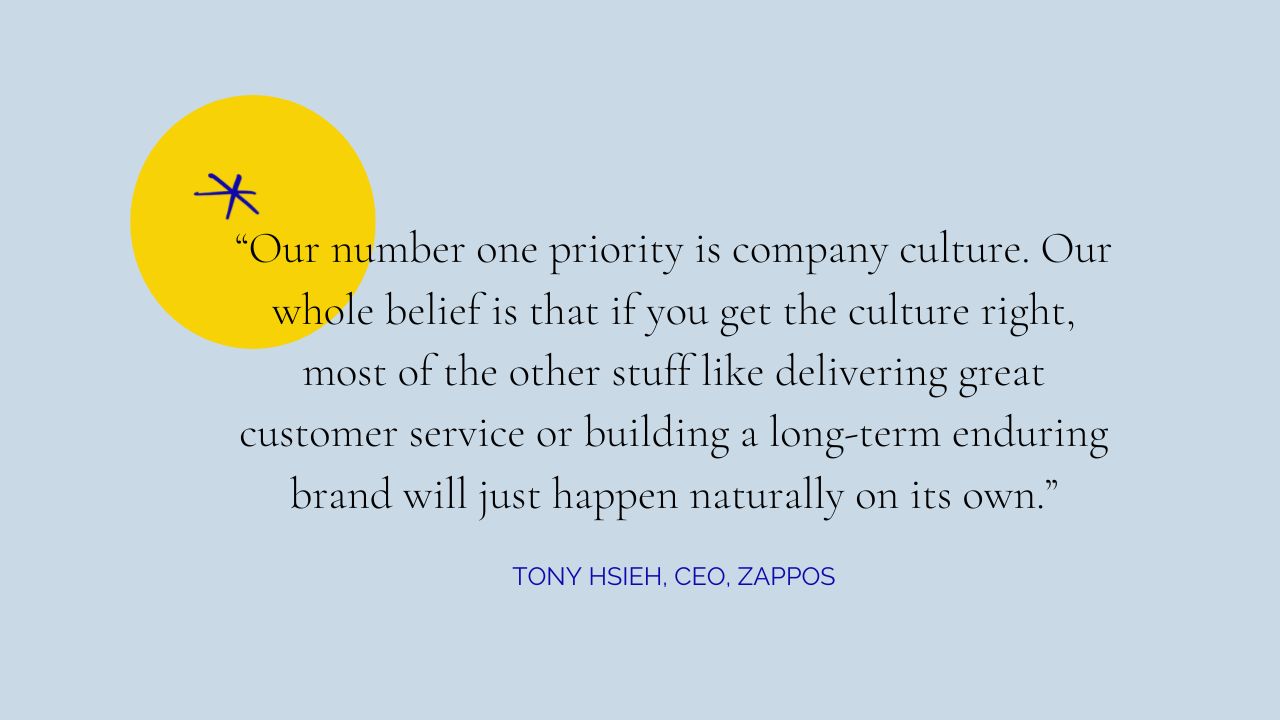
To say that Zappos take culture seriously would be an understatement. And it all starts with WOWing the customer. Here’s how they express that:
'At Zappos, anything worth doing is worth doing with WOW. WOW is such a short, simple word, but it really encompasses a lot of things. To WOW, you must differentiate yourself, which means do something a little unconventional and innovative. You must WOW (go above and beyond what's expected) in every interaction with co-workers, vendors, customers, the community, investors – with everyone. And whatever you do must have an emotional impact on the receiver. We are not an average company, our service is not average, and we don't want our people to be average. We expect every employee to deliver WOW. Whether internally with co-workers or externally with our customers and partners, delivering WOW results in word of mouth. Our philosophy at Zappos is to WOW with service and experience, not with anything that relates directly to monetary compensation (for example, we don't offer blanket discounts or promotions to customers). We seek to WOW our customers, our co-workers, our vendors, our partners, and in the long run, our investors.'
Ask yourself: What are things you can improve upon in your work or attitude to WOW more people? Have you WOWed at least one person today?
Sample Behaviors for this value:
- Helps even when it “isn’t their job”
- Wows everyone, everywhere
- Actually makes me say “wow”
They explain the value using more impactful words (WOWing the customer). They explain why the value is important. They give the employee a prompt to consider every day. And they give examples of the behaviours that underpin it.
Signing up to their culture and values is part of their Oath of Employment. And the WOW language is expressed across the business every day.
Amazon differentiate their culture by not even talking about core values.
Instead they have a set of ‘leadership principles’ that they use every day:
We use our Leadership Principles every day, whether we’re discussing ideas for new projects or deciding on the best approach to solving a problem. It is just one of the things that makes Amazon peculiar.
Their first principle is Customer Obsession, explained in this way:
“Leaders start with the customer and work backwards. They work vigorously to earn and keep customer trust. Although leaders pay attention to competitors, they obsess over customers.”
This links strongly to their mission which is to be Earth’s most customer centric company:

They have been relentlessly committed to this from the beginning. 'Customer obsession' is in the infamous 1997 letter to shareholders (that Jeff Bezos attached to every letter to shareholders until his last one in 2021), and while they have added other leadership principles they have never changed this, moved it around or rearticulated it. Consistency counts. As does the level of commitment.
If you're going to use a two word phrase, customer focus won't cut it. Using Obsession and WOW helps Zappos and Amazon get across the degree of commitment they desire and helps them stand apart in the process.
Great Ormond Street
Great Ormond Street developed their values with the input of 2,644 patients, families and members of staff who told them ‘the difference we make when we are at our best’.
They break down two of their values around ‘customer focus’ (or in this case, patient and family focus) into the 2 areas of 'welcoming' and 'helpful', and then into 4 sub points and are really clear on what people want to see vs. what they don’t.

This clarity is key. Don't just say it - explain it. And use the opposite scenario to really help people get it.
When Warby Parker talk about customer focus, they pick up on a Four Seasons principle that has guided their guest relations from the beginning – the golden rule of treating others how you’d like to be treated. And throughout their values, they inject personality.

Google have also had a simple and powerful mantra from the beginning:

Focus on the user and all else will follow.
Both of these examples show that a 'mantra' can have greater meaning and impact than a word. And within it you can express some of your personality. You start to introduce a tone of voice, not just a concept.
So make your statement work for your culture.
Explore some of these ideas:
- Always build from your WHY statement, like Amazon do in their first leadership principle.
- Consider a 'call to action' or 'mantra' rather than a word or two.
- Be clear on what you expect of people - and what the opposite would feel like.
Values examples: Innovation - Meta, Zappos, Airbnb, Samsung, Uber, Nike, IBM, Toyota
Innovation is another one of those overused, empty values used by many companies.
But the best brands don’t just tell their employees to be innovative. They dig underneath it to help explain HOW.
Take Meta for instance. They have 6 values, one of which is, Move Fast:
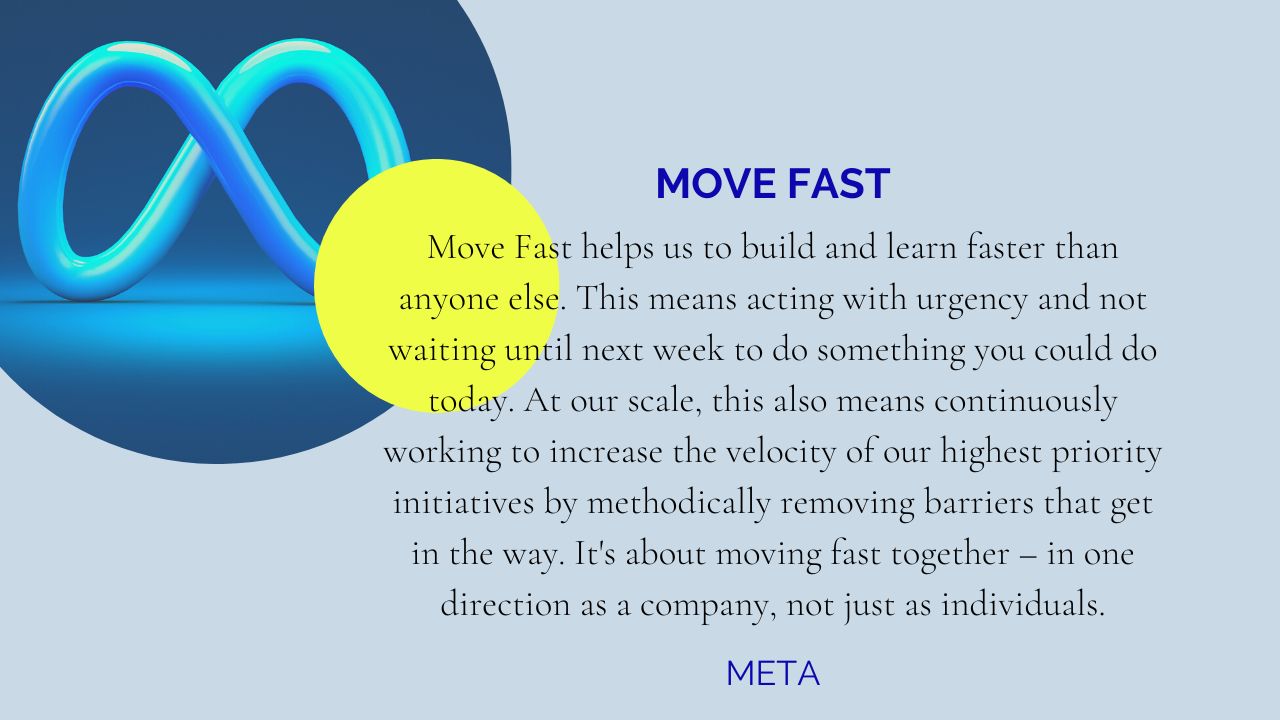
Uber emphasise the need to both see the big picture and the details. One of their values is 'See the forest and the trees'.
See the forest and the trees
Know the details that matter
Building for the intersection of the physical and digital worlds at global scale requires seeing the big picture and the details. Knowing the important details can change the approach, and small improvements can compound into enormous impact over time.
One of Samsung’s values is simply: Change.
A mantra for the company and for individuals.
Zappos don’t tell their employees to ‘be innovative’.
Instead they tell them that their mind is a gift and provoke them with some key questions.

At Zappos, we think it's important for people and the company as a whole to be bold and daring (but not reckless). We want everyone to not be afraid to take risks and to not be afraid to make mistakes, because if people aren't making mistakes then that means they're not taking enough risks. Over time, we want everyone to develop his/her gut about business decisions. We want people to develop and improve their decision-making skills. We encourage people to make mistakes as long as they learn from them. We never want to become complacent and accept the status quo just because that's the way things have always been done. We should always be seeking adventure and having fun exploring new possibilities. By having the freedom to be creative in our solutions, we end up making our own luck. We approach situations and challenges with an open mind. Sometimes our sense of adventure and creativity causes us to be unconventional in our solutions (because we have the freedom to think outside the box), but that's what allows us to rise above and stay ahead of the competition.
Ask yourself: Are you taking enough risks? Are you afraid of making mistakes? Do you push yourself outside of your comfort zone? Is there a sense of adventure and creativity in the work that you do? What are some creative things that you can contribute to Zappos? Do you approach situations and challenges with an open mind?
Sample Behaviors for this value:
-
Takes risks in alignment with Zappos purpose
-
Thinks EVEN BIGGER
-
Willing to fail (and learn from failure)
-
Acts as an entrepreneur
Airbnb use a story to help to embed innovation in their organisation.

Why is this great?
Because it doesn't just tell employees what's expected of them, it opens the door to Airbnb's founding story.
This is no spelling mistake, it’s a very clever way of writing a corporate value that helps to explain what led to their success and the type of entrepreneurial spirit that will continue to help them grow.
Nike also build from their heritage – telling people to always ‘remember the man.’

That man was Bill Bowerman, who constantly tinkered with the track team’s shoes to improve performance. Burning his waffle pan in the process.
But he didn’t just invent a new shoe base. Partnering with a cardiologist, he researched and wrote about jogging and its positive impact on fitness, in a 90 page book, creating a category for the shoe, not just a product for the category.
'Remember the man' is a reminder to innovate on the product and category level, and a door that encourages employees to learn more about the heritage and stories of the company.
IBM broke down one of their 3 values: 'Innovation that matters - for our company and for the world’ into three core values that help people understand HOW they should do things:
- Relentlessly reinvent – our company and ourselves
- Dare to create original ideas
- Treasure wild ducks.
I know which one made you pause.
Why are Wild Ducks in IBM’s brand strategy?
Because this captures how to contribute to ‘innovation that matters’ in a different, meaningful and memorable way.
Former IBM Chairman, Thomas J. Watson, Jr., explained that:
"In IBM we frequently refer to our need for 'wild ducks.' The moral is drawn from a story by the Danish philosopher, Soren Kierkegaard who told of a man who fed the wild ducks flying south in great flocks each fall. After a while some of the ducks no longer bothered to fly south; they wintered in Denmark on what he fed them. In time they flew less and less. After three or four years they grew so lazy and fat that they found difficulty in flying at all. Kierkegaard drew his point: you can make wild ducks tame, but you can never make tame ducks wild again. One might also add that the duck who is tamed will never go anywhere any more. We are convinced that any business needs its wild ducks. And in IBM we try not to tame them."
You can see the power and potential of this idea in this film they made to celebrate their centennial.
It’s a lot more impactful than just telling their employees to be innovative.
As Curt Steinhorst writes in Rethinking the value of Core Values:
The path to success is to focus first on the stories your people and your customers tell about your company and share with one another. What is celebrated, what draws attention, what does “everyone” care about? What tales are modern legends in your company? Where does your organization find its pride, or its shame? Its hope, or its despair? Its honor and its humanity?
Toyota also embrace values around innovation that require you to explain their meaning and dig deeper into the heritage of the company.
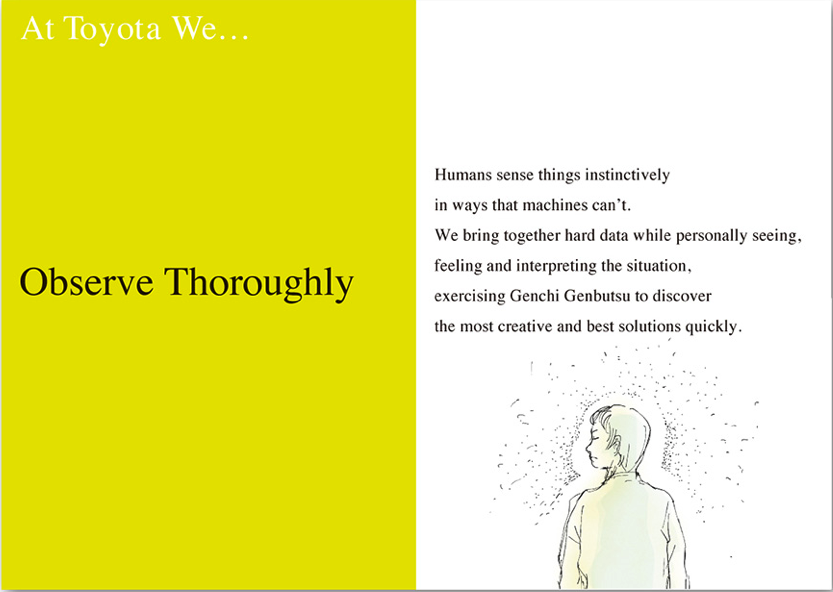
Exercising Genchi Genbutsu, as Toyota explains, means:
Go and see for yourself: The best practice is to go and see the location or process where the problem exists in order to solve that problem more quickly and efficiently. To grasp problems, confirm the facts and analyse root causes.
It's one of the 12 pillars of their Toyota Production System.
The other simple, but effective, tactic they use is to link their values to their business. Drive curiosity rather than just 'be curious', and discover the 'mechanics' behind the phenomena.
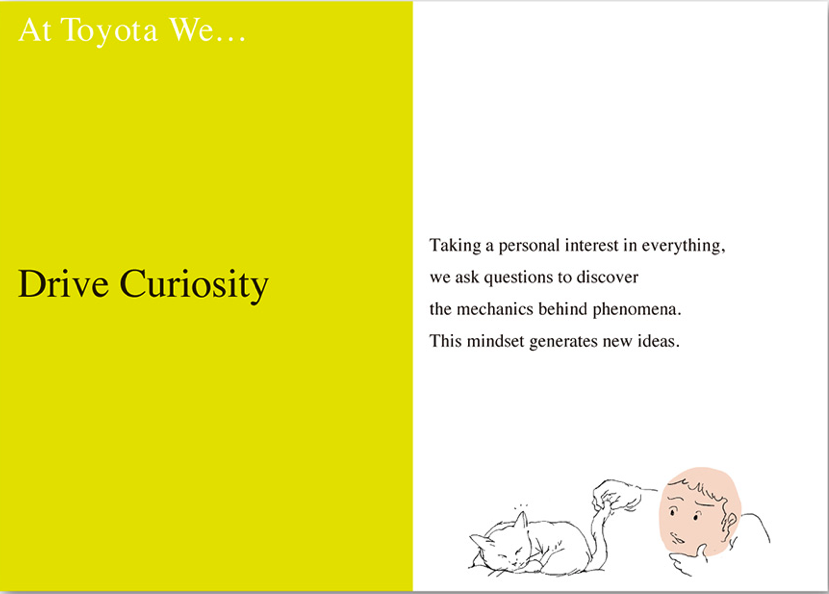
Five ways to write values with more meaning
In summary, you can identify more meaningful, engaging and actionable values for your company in the following ways.
1. Consider the structure - you don't have to use one word for each value! The 'command' model can be much more effective. Drive curiosity; move fast; be a cereal entrepreneur - these all encourage you to take action.
2. Define what’s underneath the words; help employees understand HOW to be innovative vs. just telling them it’s important.
3. Tap into heritage and founding stories. (Be a cereal entrepreneur; Treasure wild ducks, Remember the man).
4. Ensure the values connect with other parts of the brand strategy - in particular WHY you exist - to reinforce why the value is important in the first place.
5. Inject your personality and tone of voice. Consider hiring a copywriter to do your final version.
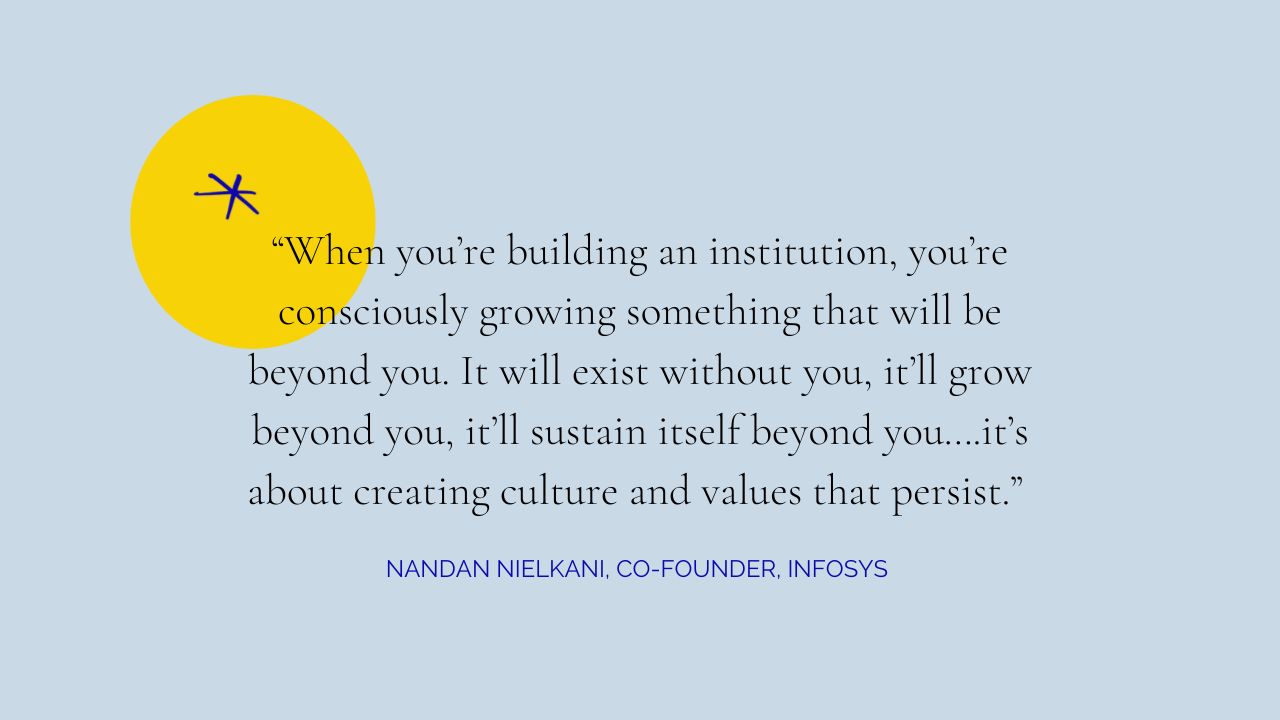
Hope this helps!
If you want more examples, and to understand how to create the other parts of your brand strategy, then Brand Strategy Academy is for you.
Get brand strategy smarter in 5 minutes a week
Join our weekly newsletter. No fluff. Sent Fridays.
By clicking the button, you agree to receive the 'Brand Strategy Smarter' newsletter and marketing emails from Brand Strategy Sarah about our products and services. Unsubscribe at any time.



